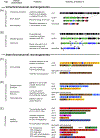Complex genomic rearrangements: an underestimated cause of rare diseases
- PMID: 35820967
- PMCID: PMC9851044
- DOI: 10.1016/j.tig.2022.06.003
Complex genomic rearrangements: an underestimated cause of rare diseases
Abstract
Complex genomic rearrangements (CGRs) are known contributors to disease but are often missed during routine genetic screening. Identifying CGRs requires (i) identifying copy number variants (CNVs) concurrently with inversions, (ii) phasing multiple breakpoint junctions incis, as well as (iii) detecting and resolving structural variants (SVs) within repeats. We demonstrate how combining cytogenetics and new sequencing methodologies is being successfully applied to gain insights into the genomic architecture of CGRs. In addition, we review CGR patterns and molecular features revealed by studying constitutional genomic disorders. These data offer invaluable lessons to individuals interested in investigating CGRs, evaluating their clinical relevance and frequency, as well as assessing their impact(s) on rare genetic diseases.
Keywords: chromosomal abnormalities; clinical diagnostics; constitutional diseases; genomic disorders; structural variation; whole-genome sequencing.
Copyright © 2022 The Author(s). Published by Elsevier Ltd.. All rights reserved.
Conflict of interest statement
Declaration of interests The authors declare no conflicts of interest.
Figures



References
-
- Pellestor F et al. (2011) Complex chromosomal rearrangements: origin and meiotic behavior. Hum. Reprod. Update 17, 476–494 - PubMed
-
- Astbury C et al. (2004) Delineation of complex chromosomal rearrangements: evidence for increased complexity. Hum. Genet. 114, 448–457 - PubMed
-
- Giardino D et al. (2009) De novo balanced chromosome rearrangements in prenatal diagnosis. Prenat. Diagn. 29, 257–265 - PubMed
Publication types
MeSH terms
Grants and funding
LinkOut - more resources
Full Text Sources
Medical

